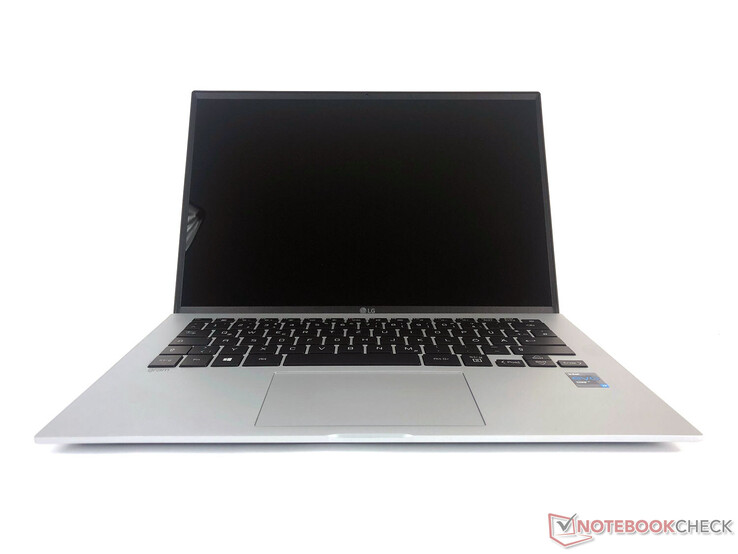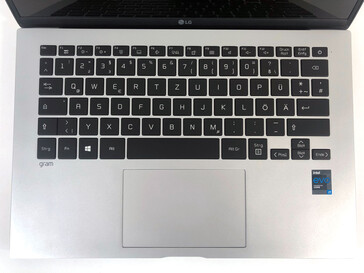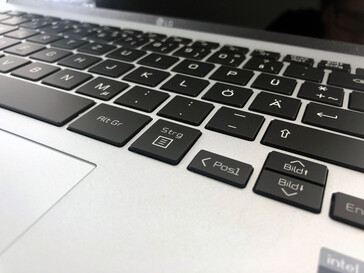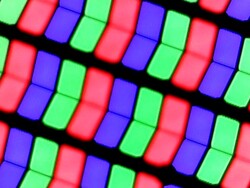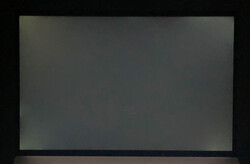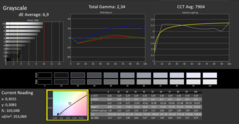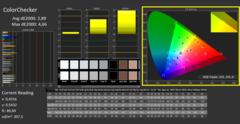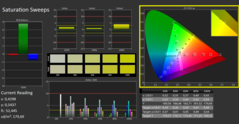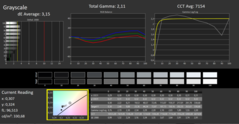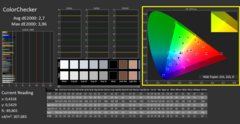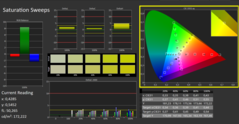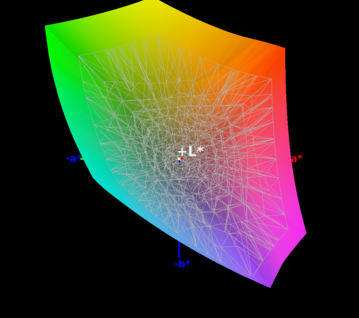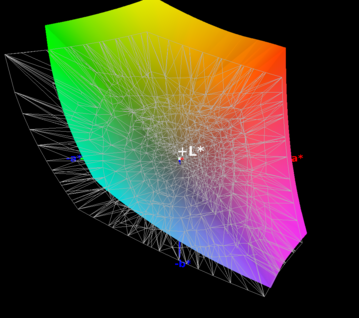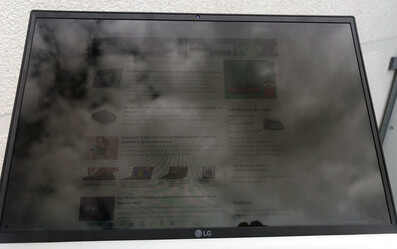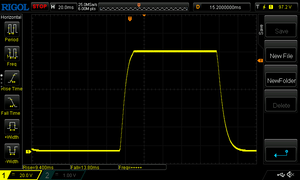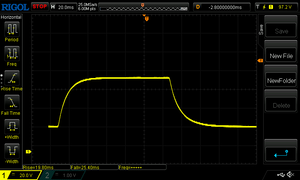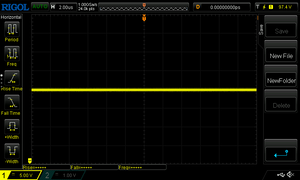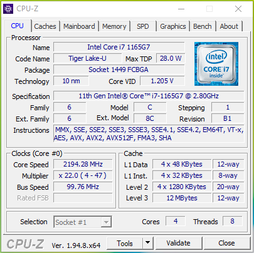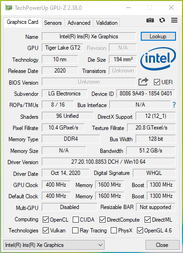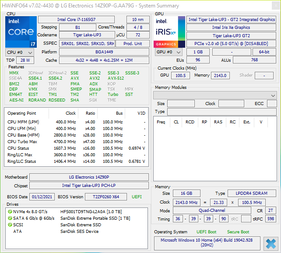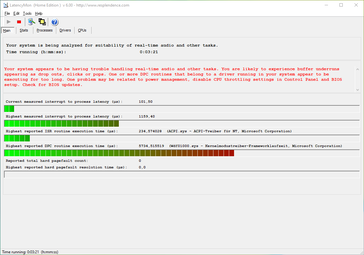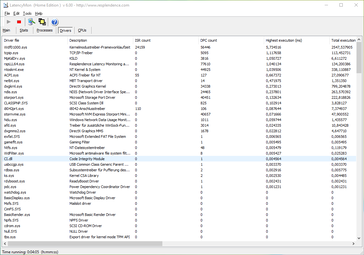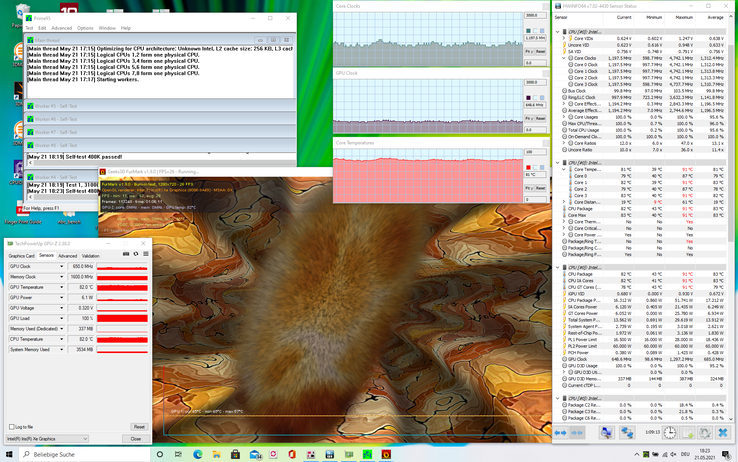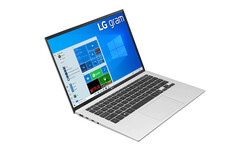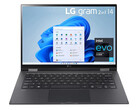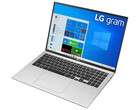LG Gram 14Z90P in review: Superior endurance and finally more performance

With the Gram 14Z90P-G.AA79G, LG once again launches an updated version for the title of the most enduring subnotebook on the market in 2021. In comparison to the LG Gram 14Z90N predecessor, the new generation is equipped with the current i7-1165G7 Tiger Lake CPU including the Iris Xe G7 96EUs integrated GPU. In addition, there's 16 GB of RAM and a 14-inch IPS panel with a resolution of 1920x1200 pixels.
Not only will we take a look in our review of the new LG Gram 14Z90P at how well the updated hardware performs and what advantages it offers. Naturally, when it comes to a battery prodigy like this one, we will also focus on the impact of the model update on battery life. How does the new generation compare to the predecessor and other lightweights like the Lenovo Yoga Slim 7i Carbon 13 ITL, the Asus ExpertBook B9 B9400CE-KC0166R, or the Huawei MateBook X?
Possible contenders in comparison
Rating | Date | Model | Weight | Height | Size | Resolution | Price |
|---|---|---|---|---|---|---|---|
| 88.3 % v7 (old) | 05 / 2021 | LG Gram 14Z90P-G.AA79G i7-1165G7, Iris Xe G7 96EUs | 967 g | 16.8 mm | 14.00" | 1920x1200 | |
| 85.3 % v7 (old) | 05 / 2020 | LG Gram 14Z90N i7-1065G7, Iris Plus Graphics G7 (Ice Lake 64 EU) | 994 g | 18 mm | 14.00" | 1920x1080 | |
| 87.6 % v7 (old) | 05 / 2021 | Huawei MateBook X Silver Frost (2020) i5-10210U, UHD Graphics 620 | 1 kg | 13.6 mm | 13.00" | 3000x2000 | |
| 87.6 % v7 (old) | 03 / 2021 | Lenovo Yoga Slim 7i Carbon 13 ITL i7-1165G7, Iris Xe G7 96EUs | 975 g | 15 mm | 13.30" | 2560x1600 | |
| 87.1 % v7 (old) | 03 / 2021 | Asus ExpertBook B9 B9400CE-KC0166R i7-1165G7, Iris Xe G7 96EUs | 995 g | 14.9 mm | 14.00" | 1920x1080 |
Case: Light and elegant as usual
Compared to last year's model, little has changed in terms of looks. The 2021 LG Gram 14 once again features a sophisticated and minimalistic design. Not only does the full-metal case made of a magnesium alloy make a high-quality impression and is excellently crafted, but it's also particularly robust according to the manufacturer as the compliance with the MIL-STD-810G military standard shows. Nevertheless, we didn't subject the device to a drop test.
The hinge is quite stiff. It holds the display quite firmly in its place and position, and it only wobbles slightly when moved. However, opening the device with only one hand can be a bit of a challenge, and the low weight doesn't help for once in this regard.
Besides its long battery life, the LG Gram is especially known for its low weight. This is also proven by the new LG Gram 14Z90P: Once again, it weighs less than one kilogram. Compared to last year's model, the LG Gram 14Z90N, it's slightly lighter as well as a bit narrower and thinner.
The device holds its own in the comparison field. It can't keep up with the ultra-thin Huawei MateBook X, but it offers much more performance and endurance in return. Users looking for a mobile companion that is light and compact won't go wrong with the 2021 LG Gram 14 once again.
Connectivity: Laptop with all the necessary ports
The LG Gram 14Z90P offers all the ports that are needed in everyday use. Besides USB-C/Thunderbolt 4, there's also USB-A. In addition, two external 4K monitors or an 8K display can be connected via HDMI and DisplayPort (via USB-C). All ports are distributed along the left and right sides of the case and provide sufficient distance between them for unobstructed use.
SD card reader
The microSD card reader to the right reaches average speeds with a 64 GB Toshiba Exceria Pro UHS-II SDXC reference memory card. This is sufficient to copy a few photos from a memory card. However, you should be prepared for some waiting time for larger amounts of data. We can't make a comparison with the direct competitors at this point, since they lack the corresponding slot.
| SD Card Reader | |
| average JPG Copy Test (av. of 3 runs) | |
| LG Gram 14Z90N (Toshiba Exceria Pro M501 64 GB UHS-II) | |
| LG Gram 14Z90P-G.AA79G (Toshiba Exceria Pro M501 microSDXC 64GB) | |
| Average of class Subnotebook (18.4 - 142, n=15, last 2 years) | |
| maximum AS SSD Seq Read Test (1GB) | |
| LG Gram 14Z90P-G.AA79G (Toshiba Exceria Pro M501 microSDXC 64GB) | |
| LG Gram 14Z90N (Toshiba Exceria Pro M501 64 GB UHS-II) | |
| Average of class Subnotebook (22.5 - 207, n=15, last 2 years) | |
Communication
The integrated Intel Wi-Fi 6 AX201 WLAN module is used in all comparison models. However, it delivers the worst performance in the LG Gram 14Z90P reviewed here. It's clearly behind most of the comparison models. Only Huawei's fanless MateBook X performs comparably poorly.
Webcam
The webcam that is integrated into the upper display bezel has a resolution of 720p and leaves a solid impression in the test. Color deviations are sometimes a bit higher than in the comparison models. Contrast and sharpness are okay, so the webcam is good enough for video calls and the like.
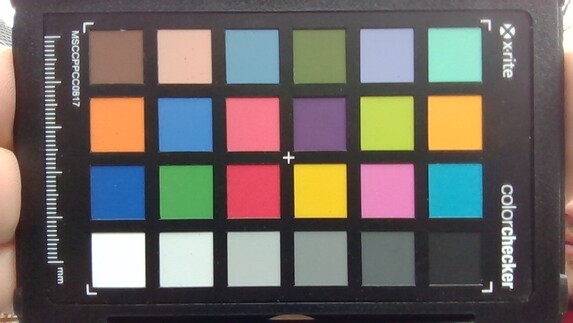
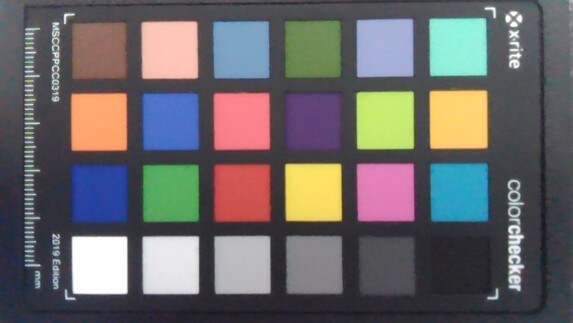
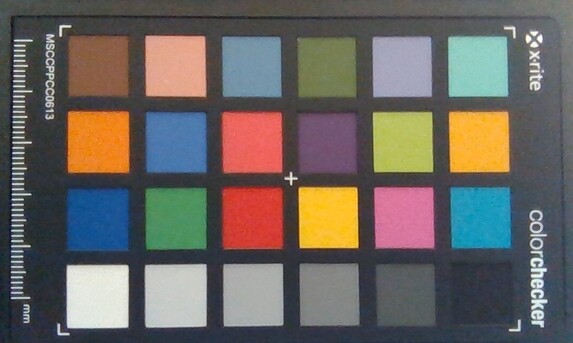
Security
In addition to a fingerprint sensor that is integrated into the device's power button on the keyboard's upper right, the laptop can also be secured with a Kensington lock.
Accessories
Apart from the 65-watt comfortably compact power adapter, LG doesn't include any other accessories with the Gram 14Z90P.
Maintenance
Self-conducted maintenance procedures are difficult to perform. All the screws on the underside are covered and consequently not readily accessible.
Warranty
LG grants customers the usual manufacturer warranty of 24 months out of the box. Optional warranty extensions aren't offered by the manufacturer.
Input devices: Improved keyboard with more travel
Keyboard
Compared to the predecessor, LG has increased the size of the keys and the key travel from 1.5 to 1.65 mm. This results in a keyboard that is comfortable to type on, and its keys have a decent travel and pressure point considering the thickness of the device. The noise development during typing is kept within limits.
LG now uses a uniform white color for the labels of the various additional functions, which were colored in the predecessor. This might make it less easy to find a specific function key, but it looks much more elegant. In addition, the backlight that illuminates the entire keyboard is helpful and can be adjusted in two stages. For this, the LG Control Center has to be accessed via "FN + F1". Unfortunately, the still very small arrow keys haven't been made bigger. But they're no longer so mushy.
Touchpad
The centered touchpad measures approximately 11 x 7 cm. It's minimally embedded in the case and has a very smooth surface. Furthermore, the mouse cursor largely responds without any issues. We couldn't find the "jamming" of the predecessor in the new model. The noise level produced by the left and right clicks is acceptable. We've experienced louder but also quieter noise levels.
Display: Unfortunately, strongly reflective
LG has installed a 14-inch IPS LCD panel with a white LED backlight in the Gram 14Z90P. The display has an aspect ratio of 16:10 with a resolution of 1920x1200 pixels. Subjectively, the display is crisp and sharp, and it doesn't give any cause for complaint.
The average brightness is a good 300 cd/m². That is solid, but especially in outdoor use, it quickly becomes the device's doom. Particularly since the display is glossy and consequently highly reflective. The brightness distribution is quite even, and screen bleeding is almost non-existent.
Compared to the predecessor, the panel in the 2021 model performs much better. LG was partly able to considerably improve many important aspects, such as contrast, brightness, and black value.
| |||||||||||||||||||||||||
Brightness Distribution: 91 %
Center on Battery: 301 cd/m²
Contrast: 1600:1 (Black: 0.22 cd/m²)
ΔE ColorChecker Calman: 2.89 | ∀{0.5-29.43 Ø4.79}
calibrated: 2.7
ΔE Greyscale Calman: 6.9 | ∀{0.09-98 Ø5}
100% sRGB (Argyll 1.6.3 3D)
76% AdobeRGB 1998 (Argyll 1.6.3 3D)
85.3% AdobeRGB 1998 (Argyll 3D)
99.9% sRGB (Argyll 3D)
97.6% Display P3 (Argyll 3D)
Gamma: 2.34
CCT: 7904 K
| LG Gram 14Z90P-G.AA79G LG Display LP140WU1-SPA1, IPS, 1920x1200, 14" | LG Gram 14Z90N LG Philips LP140WF7-SPG1, IPS, 1920x1080, 14" | Huawei MateBook X Silver Frost (2020) JDI RWLPM130M364C, LTPS, 3000x2000, 13" | Lenovo Yoga Slim 7i Carbon 13 ITL N133GCA-GQ1, a-SI IPS LED, 2560x1600, 13.3" | Asus ExpertBook B9 B9400CE-KC0166R B140HAN06.B, IPS, 1920x1080, 14" | |
|---|---|---|---|---|---|
| Display | -20% | -20% | -19% | -15% | |
| Display P3 Coverage (%) | 97.6 | 65 -33% | 64.8 -34% | 65.1 -33% | 69.8 -28% |
| sRGB Coverage (%) | 99.9 | 95.5 -4% | 95.9 -4% | 97.1 -3% | 98.8 -1% |
| AdobeRGB 1998 Coverage (%) | 85.3 | 66.1 -23% | 65.9 -23% | 66.6 -22% | 71.3 -16% |
| Response Times | -8% | 4% | 13% | -31% | |
| Response Time Grey 50% / Grey 80% * (ms) | 45 ? | 40.4 ? 10% | 43 ? 4% | 38.4 ? 15% | 60 ? -33% |
| Response Time Black / White * (ms) | 23 ? | 28.8 ? -25% | 22 ? 4% | 20.8 ? 10% | 29.6 ? -29% |
| PWM Frequency (Hz) | |||||
| Screen | -0% | 13% | 9% | 16% | |
| Brightness middle (cd/m²) | 352 | 316.8 -10% | 386 10% | 325 -8% | 437 24% |
| Brightness (cd/m²) | 332 | 298 -10% | 384 16% | 297 -11% | 421 27% |
| Brightness Distribution (%) | 91 | 89 -2% | 89 -2% | 83 -9% | 87 -4% |
| Black Level * (cd/m²) | 0.22 | 0.33 -50% | 0.24 -9% | 0.26 -18% | 0.29 -32% |
| Contrast (:1) | 1600 | 960 -40% | 1608 1% | 1250 -22% | 1507 -6% |
| Colorchecker dE 2000 * | 2.89 | 1.74 40% | 1.75 39% | 2.2 24% | 1.8 38% |
| Colorchecker dE 2000 max. * | 4.66 | 5.41 -16% | 2.92 37% | 3.5 25% | 3.5 25% |
| Colorchecker dE 2000 calibrated * | 2.7 | 1.37 49% | 0.6 78% | 1.4 48% | |
| Greyscale dE 2000 * | 6.9 | 2.7 61% | 2.33 66% | 2.8 59% | 2.3 67% |
| Gamma | 2.34 94% | 2.23 99% | 2.55 86% | 2.05 107% | 2.18 101% |
| CCT | 7904 82% | 6655 98% | 6584 99% | 6452 101% | 6782 96% |
| Color Space (Percent of AdobeRGB 1998) (%) | 76 | 61.3 -19% | 61 -20% | 61.3 -19% | 65.4 -14% |
| Color Space (Percent of sRGB) (%) | 100 | 95.4 -5% | 96 -4% | 97 -3% | 98.7 -1% |
| Total Average (Program / Settings) | -9% /
-5% | -1% /
5% | 1% /
4% | -10% /
4% |
* ... smaller is better
In contrast, color reproduction is not as good. It exhibits larger deviations out of the box that can't be improved that much even with a calibration.
On the other hand, a positive point is that color-space coverage has been significantly increased. The new LG 14Z90P covers 100% of sRGB and 76% of AdobeRGB.
Overall, the display only ranks in the midfield compared to the other models, which is mainly due to the color reproduction.
The reflective display is a hindrance for the device outdoors. What is already annoying indoors with unfavorably positioned light sources, such as windows, becomes a nightmare outdoors. As the photo below shows, a cloudy sky or even the user sitting in front of the device result in very strong reflections. Therefore, the LG Gram 14Z90P is truly not the ideal companion for outdoors, which is a pity due to the low weight. On the other hand, the IPS panel's usual high viewing angle stability is excellent.
Display Response Times
| ↔ Response Time Black to White | ||
|---|---|---|
| 23 ms ... rise ↗ and fall ↘ combined | ↗ 9 ms rise | |
| ↘ 14 ms fall | ||
| The screen shows good response rates in our tests, but may be too slow for competitive gamers. In comparison, all tested devices range from 0.1 (minimum) to 240 (maximum) ms. » 50 % of all devices are better. This means that the measured response time is worse than the average of all tested devices (20.3 ms). | ||
| ↔ Response Time 50% Grey to 80% Grey | ||
| 45 ms ... rise ↗ and fall ↘ combined | ↗ 20 ms rise | |
| ↘ 25 ms fall | ||
| The screen shows slow response rates in our tests and will be unsatisfactory for gamers. In comparison, all tested devices range from 0.165 (minimum) to 636 (maximum) ms. » 76 % of all devices are better. This means that the measured response time is worse than the average of all tested devices (31.7 ms). | ||
Screen Flickering / PWM (Pulse-Width Modulation)
| Screen flickering / PWM not detected | |||
In comparison: 53 % of all tested devices do not use PWM to dim the display. If PWM was detected, an average of 8152 (minimum: 5 - maximum: 343500) Hz was measured. | |||
Performance: LG Gram 14 with Tiger Lake performance upgrade
Compared to last year's model, the LG Gram 14Z90P has made the leap to the 11th generation of Intel CPUs. Instead of the Ice Lake i7-1065G7, the new Gram is now equipped with the Tiger Lake i7-1165G7. This is accompanied by an onboard graphics upgrade from the Iris Plus Graphics G7 64EUs to the Iris Xe G7 96EUs.
We will describe how these improvements affect performance in the following sections. We expect a performance boost, since the new CPU offers significantly more than the Ice Lake generation.
Alternatively, the Gram 14Z90P-G.AP55G is available in a Business Edition with the i5-1135G7 and a slightly different configuration for 200 Euros (~$245) less.
Processor
It's sufficiently known that Intel managed a significant performance leap with the jump from Ice Lake to Tiger Lake. This is proven by the i7-1165G7 in the LG Gram 14Z90P. The new model is considerably ahead of the predecessor with its i7-1065G7 in all benchmarks.
Compared to the other reference models, the CPU with 18 watts (PL1) to 52 watts (PL2) is a solid competitor, but it's often close to the bottom in the duel against the identically equipped Lenovo Yoga Slim 7i Carbon 13 ITL ITL and the Asus ExpertBook B9. The LG subnotebook can't quite keep up with the processor's average rate either. A performance drop on battery power is hardly noticeable.
Cinebench R20: CPU (Single Core) | CPU (Multi Core)
Cinebench R15: CPU Single 64Bit | CPU Multi 64Bit
Blender: v2.79 BMW27 CPU
7-Zip 18.03: 7z b 4 -mmt1 | 7z b 4
Geekbench 5.5: Single-Core | Multi-Core
HWBOT x265 Benchmark v2.2: 4k Preset
LibreOffice : 20 Documents To PDF
R Benchmark 2.5: Overall mean
| Cinebench R23 / Single Core | |
| Average of class Subnotebook (358 - 2165, n=79, last 2 years) | |
| Average Intel Core i7-1165G7 (1110 - 1539, n=59) | |
| Asus ExpertBook B9 B9400CE-KC0166R | |
| Lenovo Yoga Slim 7i Carbon 13 ITL | |
| LG Gram 14Z90P-G.AA79G | |
| Huawei MateBook X Silver Frost (2020) | |
| Cinebench R23 / Multi Core | |
| Average of class Subnotebook (1555 - 21812, n=78, last 2 years) | |
| Average Intel Core i7-1165G7 (2525 - 6862, n=64) | |
| Asus ExpertBook B9 B9400CE-KC0166R | |
| LG Gram 14Z90P-G.AA79G | |
| Lenovo Yoga Slim 7i Carbon 13 ITL | |
| Huawei MateBook X Silver Frost (2020) | |
| Cinebench R20 / CPU (Single Core) | |
| Average of class Subnotebook (128 - 826, n=71, last 2 years) | |
| Asus ExpertBook B9 B9400CE-KC0166R | |
| Lenovo Yoga Slim 7i Carbon 13 ITL | |
| Average Intel Core i7-1165G7 (442 - 589, n=81) | |
| LG Gram 14Z90P-G.AA79G | |
| LG Gram 14Z90N | |
| Huawei MateBook X Silver Frost (2020) | |
| Cinebench R20 / CPU (Multi Core) | |
| Average of class Subnotebook (579 - 8541, n=71, last 2 years) | |
| Asus ExpertBook B9 B9400CE-KC0166R | |
| Average Intel Core i7-1165G7 (1060 - 2657, n=81) | |
| Lenovo Yoga Slim 7i Carbon 13 ITL | |
| LG Gram 14Z90P-G.AA79G | |
| LG Gram 14Z90N | |
| Huawei MateBook X Silver Frost (2020) | |
| Cinebench R15 / CPU Single 64Bit | |
| Average of class Subnotebook (72.4 - 322, n=72, last 2 years) | |
| Lenovo Yoga Slim 7i Carbon 13 ITL | |
| Asus ExpertBook B9 B9400CE-KC0166R | |
| Average Intel Core i7-1165G7 (115 - 230, n=78) | |
| LG Gram 14Z90P-G.AA79G | |
| LG Gram 14Z90N | |
| Huawei MateBook X Silver Frost (2020) | |
| Cinebench R15 / CPU Multi 64Bit | |
| Average of class Subnotebook (327 - 3345, n=74, last 2 years) | |
| Asus ExpertBook B9 B9400CE-KC0166R | |
| Average Intel Core i7-1165G7 (553 - 1027, n=86) | |
| Lenovo Yoga Slim 7i Carbon 13 ITL | |
| LG Gram 14Z90P-G.AA79G | |
| LG Gram 14Z90N | |
| Huawei MateBook X Silver Frost (2020) | |
| Blender / v2.79 BMW27 CPU | |
| Huawei MateBook X Silver Frost (2020) | |
| LG Gram 14Z90N | |
| Lenovo Yoga Slim 7i Carbon 13 ITL | |
| LG Gram 14Z90P-G.AA79G | |
| Average Intel Core i7-1165G7 (468 - 1138, n=80) | |
| Asus ExpertBook B9 B9400CE-KC0166R | |
| Average of class Subnotebook (159 - 2271, n=74, last 2 years) | |
| 7-Zip 18.03 / 7z b 4 -mmt1 | |
| Average of class Subnotebook (2643 - 6442, n=73, last 2 years) | |
| Lenovo Yoga Slim 7i Carbon 13 ITL | |
| Asus ExpertBook B9 B9400CE-KC0166R | |
| Average Intel Core i7-1165G7 (4478 - 5507, n=80) | |
| LG Gram 14Z90P-G.AA79G | |
| LG Gram 14Z90N | |
| Huawei MateBook X Silver Frost (2020) | |
| 7-Zip 18.03 / 7z b 4 | |
| Average of class Subnotebook (11668 - 77867, n=71, last 2 years) | |
| Asus ExpertBook B9 B9400CE-KC0166R | |
| Average Intel Core i7-1165G7 (15347 - 27405, n=80) | |
| LG Gram 14Z90P-G.AA79G | |
| Lenovo Yoga Slim 7i Carbon 13 ITL | |
| LG Gram 14Z90N | |
| Huawei MateBook X Silver Frost (2020) | |
| Geekbench 5.5 / Single-Core | |
| Average of class Subnotebook (726 - 2350, n=67, last 2 years) | |
| Lenovo Yoga Slim 7i Carbon 13 ITL | |
| Average Intel Core i7-1165G7 (1302 - 1595, n=77) | |
| LG Gram 14Z90P-G.AA79G | |
| Asus ExpertBook B9 B9400CE-KC0166R | |
| Huawei MateBook X Silver Frost (2020) | |
| LG Gram 14Z90N | |
| Geekbench 5.5 / Multi-Core | |
| Average of class Subnotebook (2557 - 17218, n=67, last 2 years) | |
| Lenovo Yoga Slim 7i Carbon 13 ITL | |
| Average Intel Core i7-1165G7 (3078 - 5926, n=77) | |
| Asus ExpertBook B9 B9400CE-KC0166R | |
| LG Gram 14Z90P-G.AA79G | |
| Huawei MateBook X Silver Frost (2020) | |
| LG Gram 14Z90N | |
| HWBOT x265 Benchmark v2.2 / 4k Preset | |
| Average of class Subnotebook (0.97 - 25.1, n=71, last 2 years) | |
| Asus ExpertBook B9 B9400CE-KC0166R | |
| Average Intel Core i7-1165G7 (1.39 - 8.47, n=80) | |
| LG Gram 14Z90P-G.AA79G | |
| Lenovo Yoga Slim 7i Carbon 13 ITL | |
| LG Gram 14Z90N | |
| Huawei MateBook X Silver Frost (2020) | |
| LibreOffice / 20 Documents To PDF | |
| Huawei MateBook X Silver Frost (2020) | |
| LG Gram 14Z90N | |
| Average of class Subnotebook (38.5 - 220, n=70, last 2 years) | |
| Lenovo Yoga Slim 7i Carbon 13 ITL | |
| Asus ExpertBook B9 B9400CE-KC0166R | |
| Average Intel Core i7-1165G7 (21.5 - 88.1, n=78) | |
| LG Gram 14Z90P-G.AA79G | |
| R Benchmark 2.5 / Overall mean | |
| Huawei MateBook X Silver Frost (2020) | |
| LG Gram 14Z90N | |
| LG Gram 14Z90P-G.AA79G | |
| Average Intel Core i7-1165G7 (0.552 - 1.002, n=80) | |
| Asus ExpertBook B9 B9400CE-KC0166R | |
| Lenovo Yoga Slim 7i Carbon 13 ITL | |
| Average of class Subnotebook (0.403 - 1.456, n=72, last 2 years) | |
* ... smaller is better
System performance
The new LG Gram 14 also keeps up with the test field in terms of system performance, and it usually leaves the predecessor clearly behind. Here, it mostly manages to surpass the subnotebook and hardware average.
The device doesn't show any noticeable weaknesses in everyday use. In our test, it mastered all the typical tasks for a laptop of this type without issues or deficiencies.
| PCMark 8 Home Score Accelerated v2 | 5361 points | |
| PCMark 8 Creative Score Accelerated v2 | 7401 points | |
| PCMark 8 Work Score Accelerated v2 | 3122 points | |
| PCMark 10 Score | 4877 points | |
Help | ||
DPC latencies
The LG Gram 14Z90P shows solid latencies in the test. Although the measurement is always only a snapshot, the determined value is clearly below that of the predecessor. However, the test candidate can't entirely keep up with the other comparison subnotebooks. This could point to problems with real-time audio, but these weren't observed in the test period.
| DPC Latencies / LatencyMon - interrupt to process latency (max), Web, Youtube, Prime95 | |
| LG Gram 14Z90N | |
| LG Gram 14Z90P-G.AA79G | |
| Lenovo Yoga Slim 7i Carbon 13 ITL | |
| Huawei MateBook X Silver Frost (2020) | |
| Asus ExpertBook B9 B9400CE-KC0166R | |
* ... smaller is better
Storage
The Hynix HFS001TD9TNG-L2A0A mass storage devices makes an excellent impression in the test and usually delivers the best performance in the individual measurements. The storage solutions of the comparison devices all score around 15% worse, and the subnotebook average is even 40% worse. This means that LG has equipped the current LG Gram 14Z90P with a fast M.2 SSD as the benchmarks prove.
| LG Gram 14Z90P-G.AA79G SK Hynix PC601 1TB HFS001TD9TNG | LG Gram 14Z90N Samsung SSD PM981 MZVLB256HAHQ | Huawei MateBook X Silver Frost (2020) Samsung SSD PM981a MZVLB512HBJQ | Lenovo Yoga Slim 7i Carbon 13 ITL Samsung SSD PM981a MZVLB512HBJQ | Asus ExpertBook B9 B9400CE-KC0166R Samsung PM981a MZVLB1T0HBLR | Average SK Hynix PC601 1TB HFS001TD9TNG | |
|---|---|---|---|---|---|---|
| CrystalDiskMark 5.2 / 6 | -17% | -15% | -14% | -11% | -0% | |
| Write 4K (MB/s) | 198.9 | 183.6 -8% | 164.5 -17% | 139.5 -30% | 153.5 -23% | 202 ? 2% |
| Read 4K (MB/s) | 55.9 | 48.51 -13% | 50.7 -9% | 36.38 -35% | 47.69 -15% | 51.5 ? -8% |
| Write Seq (MB/s) | 2441 | 1520 -38% | 1813 -26% | 1977 -19% | 2037 -17% | 2481 ? 2% |
| Read Seq (MB/s) | 1939 | 1914 -1% | 1722 -11% | 2207 14% | 2208 14% | 1844 ? -5% |
| Write 4K Q32T1 (MB/s) | 631 | 529 -16% | 368.5 -42% | 510 -19% | 516 -18% | 650 ? 3% |
| Read 4K Q32T1 (MB/s) | 704 | 560 -20% | 492.2 -30% | 387.8 -45% | 366.8 -48% | 732 ? 4% |
| Write Seq Q32T1 (MB/s) | 2566 | 1540 -40% | 2986 16% | 2986 16% | 3021 18% | 2540 ? -1% |
| Read Seq Q32T1 (MB/s) | 3451 | 3408 -1% | 3548 3% | 3540 3% | 3532 2% | 3452 ? 0% |
| AS SSD | -36% | -2% | -4% | -4% | 3% | |
| Seq Read (MB/s) | 2975 | 1744 -41% | 2800 -6% | 2861 -4% | 2784 -6% | 2892 ? -3% |
| Seq Write (MB/s) | 1261 | 1450 15% | 2358 87% | 1321 5% | 1362 8% | 1803 ? 43% |
| 4K Read (MB/s) | 49.97 | 57.4 15% | 59.2 18% | 52.5 5% | 52.5 5% | 50.1 ? 0% |
| 4K Write (MB/s) | 168.4 | 140.9 -16% | 142.6 -15% | 196.7 17% | 202.3 20% | 153.5 ? -9% |
| 4K-64 Read (MB/s) | 1539 | 907 -41% | 1260 -18% | 1153 -25% | 1136 -26% | 1562 ? 1% |
| 4K-64 Write (MB/s) | 1517 | 1372 -10% | 1408 -7% | 1807 19% | 1642 8% | 1602 ? 6% |
| Access Time Read * (ms) | 0.036 | 0.059 -64% | 0.048 -33% | 0.064 -78% | 0.038 -6% | 0.0355 ? 1% |
| Access Time Write * (ms) | 0.026 | 0.081 -212% | 0.026 -0% | 0.018 31% | 0.017 35% | 0.027 ? -4% |
| Score Read (Points) | 1886 | 1138 -40% | 1599 -15% | 1491 -21% | 1467 -22% | 1901 ? 1% |
| Score Write (Points) | 1811 | 1658 -8% | 1786 -1% | 2136 18% | 1980 9% | 1936 ? 7% |
| Score Total (Points) | 4579 | 3380 -26% | 4192 -8% | 4322 -6% | 4135 -10% | 4757 ? 4% |
| Copy ISO MB/s (MB/s) | 1510 | 1520 1% | 1746 16% | 1737 15% | 1681 ? 11% | |
| Copy Program MB/s (MB/s) | 950 | 539 -43% | 725 -24% | 479.1 -50% | 827 ? -13% | |
| Copy Game MB/s (MB/s) | 1470 | 1070 -27% | 1203 -18% | 935 -36% | 1400 ? -5% | |
| Total Average (Program / Settings) | -27% /
-29% | -9% /
-6% | -9% /
-8% | -8% /
-7% | 2% /
2% |
* ... smaller is better
Continuous load read: DiskSpd Read Loop, Queue Depth 8
Graphics card
While the new CPU brings a good gain in performance compared to the predecessor, graphics performance makes a real leap. This shows how much faster and better the new Iris Xe G7 96EUs GPU is compared to the predecessor Iris Plus Graphics G7 64EUs. The reason for this is that all 96 EUs operate at a clock rate of 400 to 1,300 MHz.
In the graphics benchmarks, the LG Gram 14Z90P pulverizes the performance of its predecessor, the LG Gram 14Z90N. As a result, there is a clear performance increase compared to the predecessor. The device also stands out in comparison to the other subnotebooks. It can easily keep up with the comparably equipped Lenovo Yoga Slim 7i Carbon 13 ITL and Asus ExpertBook B9 B9400CE-KC0166R alternatives, and it often even achieves the best score. The current Gram 14 is also clearly above the average of all devices with the same GPU. Not only does LG focus on long battery life, but it also pushes the hardware to the limit when necessary. In addition, benchmark performance is hardly lower on battery power (about 5%).
| 3DMark 11 Performance | 6851 points | |
| 3DMark Cloud Gate Standard Score | 17053 points | |
| 3DMark Fire Strike Score | 5013 points | |
| 3DMark Time Spy Score | 1753 points | |
Help | ||
Gaming performance
Despite having more graphics power, the LG Gram 14Z90P is certainly still not a gaming machine in the end. However, it can definitely be used for the occasional game thanks to the up-to-date hardware. The Witcher 3 ran well on medium graphics settings in our test, but other titles were only playable on the lowest settings at times.
Compared to the other models, the current LG Gram 14 performs well. It can outperform the rest of the devices as well as the graphics solution's average rate. In short: The lightweight is suitable for the occasional gaming session. However, you shouldn't have high expectations here.
| The Witcher 3 | |
| 1366x768 Medium Graphics & Postprocessing | |
| Average of class Subnotebook (33.4 - 118, n=21, last 2 years) | |
| Asus ExpertBook B9 B9400CE-KC0166R | |
| LG Gram 14Z90P-G.AA79G | |
| Average Intel Iris Xe Graphics G7 96EUs (21.4 - 77.8, n=185) | |
| Lenovo Yoga Slim 7i Carbon 13 ITL | |
| Huawei MateBook X Silver Frost (2020) | |
| 1920x1080 High Graphics & Postprocessing (Nvidia HairWorks Off) | |
| Average of class Subnotebook (11.2 - 71, n=33, last 2 years) | |
| Asus ExpertBook B9 B9400CE-KC0166R | |
| LG Gram 14Z90P-G.AA79G | |
| Average Intel Iris Xe Graphics G7 96EUs (10.6 - 45.9, n=191) | |
| Lenovo Yoga Slim 7i Carbon 13 ITL | |
| 1920x1080 Ultra Graphics & Postprocessing (HBAO+) | |
| Average of class Subnotebook (8.5 - 43.7, n=35, last 2 years) | |
| LG Gram 14Z90P-G.AA79G | |
| Asus ExpertBook B9 B9400CE-KC0166R | |
| Average Intel Iris Xe Graphics G7 96EUs (8.79 - 20.1, n=181) | |
| low | med. | high | ultra | |
|---|---|---|---|---|
| The Witcher 3 (2015) | 90.1 | 56.1 | 29.3 | 15.8 |
| Final Fantasy XV Benchmark (2018) | 40.9 | 21.3 | 16.4 | |
| X-Plane 11.11 (2018) | 24 | 34.9 | 31.3 |
Emissions: Runs pleasantly cool
Noise emissions
The LG Gram 14Z90P not only runs for a long time, but it also does so pleasantly quietly. It only just surpasses the limit of 30 dB(A) even under maximum load. Therefore, the laptop's noise level always stays pleasantly in the background, it's never intrusive, and it's barely audible at 26 dB(A) in idle usage.
A slight coil whine can be heard in our test device when listening very closely. At a normal sitting distance, however, this is only minimally audible in completely quiet environments.
Noise level
| Idle |
| 26 / 26 / 26 dB(A) |
| Load |
| 30.5 / 30.5 dB(A) |
 | ||
30 dB silent 40 dB(A) audible 50 dB(A) loud |
||
min: | ||
Temperature
Under low load, the Gram 14Z90P doesn't heat up above room temperature, and it doesn't even crack the 25 °C (~77 °F) mark. When the device is put under load, the temperature rises to around 47 °C (~177 °F). However, since the warmest spot is at the center directly in front of the display as usual, the temperature increase is not very noticeable for the user's hands. Meanwhile, the palm rest area hardly gets warmer when typing than it is in idle mode.
During our standard stress test, in which the CPU and GPU run at full load for an hour at least, the CPU and GPU operate at their limits for a few seconds. After that, the processor clock speed settles at around 1,200 MHz and the graphics clock rate at 650 MHz. The temperature is just over 80 °C (~176 °F). This means that LG throttles the processor considerably under load so that the cooling system doesn't have to work too loudly. A 3DMark 11 benchmark conducted directly after the stress test didn't show any irregularities.
(-) The maximum temperature on the upper side is 47.2 °C / 117 F, compared to the average of 35.9 °C / 97 F, ranging from 21.4 to 59 °C for the class Subnotebook.
(-) The bottom heats up to a maximum of 45.8 °C / 114 F, compared to the average of 39.3 °C / 103 F
(+) In idle usage, the average temperature for the upper side is 22.3 °C / 72 F, compared to the device average of 30.8 °C / 87 F.
(+) The palmrests and touchpad are cooler than skin temperature with a maximum of 25.7 °C / 78.3 F and are therefore cool to the touch.
(+) The average temperature of the palmrest area of similar devices was 28.2 °C / 82.8 F (+2.5 °C / 4.5 F).
Speakers
LG has installed stereo speakers of 2 watts each and support for DTS:X Ultra in the LG Gram 14Z90P. Their quality can be described as being solid. Bass is clearly lacking, but many laptops suffer from this. Mids are reproduced in a balanced way, and trebles are also acceptable. Overall, the device can position itself in the upper third of all tested subnotebooks.
LG Gram 14Z90P-G.AA79G audio analysis
(±) | speaker loudness is average but good (76.8 dB)
Bass 100 - 315 Hz
(-) | nearly no bass - on average 18.4% lower than median
(±) | linearity of bass is average (12.3% delta to prev. frequency)
Mids 400 - 2000 Hz
(+) | balanced mids - only 2.3% away from median
(+) | mids are linear (4.7% delta to prev. frequency)
Highs 2 - 16 kHz
(±) | higher highs - on average 5.1% higher than median
(+) | highs are linear (6.1% delta to prev. frequency)
Overall 100 - 16.000 Hz
(±) | linearity of overall sound is average (15.4% difference to median)
Compared to same class
» 34% of all tested devices in this class were better, 5% similar, 60% worse
» The best had a delta of 5%, average was 18%, worst was 53%
Compared to all devices tested
» 22% of all tested devices were better, 4% similar, 74% worse
» The best had a delta of 4%, average was 24%, worst was 134%
Lenovo Yoga Slim 7i Carbon 13 ITL audio analysis
(±) | speaker loudness is average but good (78.5 dB)
Bass 100 - 315 Hz
(±) | reduced bass - on average 14.8% lower than median
(-) | bass is not linear (15.8% delta to prev. frequency)
Mids 400 - 2000 Hz
(+) | balanced mids - only 4.4% away from median
(±) | linearity of mids is average (7.3% delta to prev. frequency)
Highs 2 - 16 kHz
(+) | balanced highs - only 1.3% away from median
(+) | highs are linear (5.4% delta to prev. frequency)
Overall 100 - 16.000 Hz
(+) | overall sound is linear (14.9% difference to median)
Compared to same class
» 32% of all tested devices in this class were better, 5% similar, 63% worse
» The best had a delta of 5%, average was 18%, worst was 53%
Compared to all devices tested
» 19% of all tested devices were better, 4% similar, 77% worse
» The best had a delta of 4%, average was 24%, worst was 134%
Asus ExpertBook B9 B9400CE-KC0166R audio analysis
(±) | speaker loudness is average but good (77.7 dB)
Bass 100 - 315 Hz
(±) | reduced bass - on average 14.2% lower than median
(±) | linearity of bass is average (11.1% delta to prev. frequency)
Mids 400 - 2000 Hz
(+) | balanced mids - only 3.4% away from median
(+) | mids are linear (3.4% delta to prev. frequency)
Highs 2 - 16 kHz
(+) | balanced highs - only 2.6% away from median
(+) | highs are linear (3.6% delta to prev. frequency)
Overall 100 - 16.000 Hz
(+) | overall sound is linear (14.2% difference to median)
Compared to same class
» 27% of all tested devices in this class were better, 6% similar, 67% worse
» The best had a delta of 5%, average was 18%, worst was 53%
Compared to all devices tested
» 16% of all tested devices were better, 4% similar, 80% worse
» The best had a delta of 4%, average was 24%, worst was 134%
Energy management: The LG Gram 14Z90P shows its usual endurance in the test
Energy consumption
When it comes to energy and how it's handled, we've arrived at the LG Gram 14Z90P's main discipline. The device's power consumption is almost always below the competitors' rates. Even the passively cooled and significantly less powerful Huawei MateBook X usually consumes more watts. The power adapter of the new 2021 LG Gram 14 has absolutely sufficient capacity at 65 watts, and it still has some reserves.
| Off / Standby | |
| Idle | |
| Load |
|
Key:
min: | |
| LG Gram 14Z90P-G.AA79G i7-1165G7, Iris Xe G7 96EUs, SK Hynix PC601 1TB HFS001TD9TNG, IPS, 1920x1200, 14" | LG Gram 14Z90N i7-1065G7, Iris Plus Graphics G7 (Ice Lake 64 EU), Samsung SSD PM981 MZVLB256HAHQ, IPS, 1920x1080, 14" | Huawei MateBook X Silver Frost (2020) i5-10210U, UHD Graphics 620, Samsung SSD PM981a MZVLB512HBJQ, LTPS, 3000x2000, 13" | Lenovo Yoga Slim 7i Carbon 13 ITL i7-1165G7, Iris Xe G7 96EUs, Samsung SSD PM981a MZVLB512HBJQ, a-SI IPS LED, 2560x1600, 13.3" | Asus ExpertBook B9 B9400CE-KC0166R i7-1165G7, Iris Xe G7 96EUs, Samsung PM981a MZVLB1T0HBLR, IPS, 1920x1080, 14" | Average Intel Iris Xe Graphics G7 96EUs | Average of class Subnotebook | |
|---|---|---|---|---|---|---|---|
| Power Consumption | -1% | -18% | -42% | -19% | -66% | -44% | |
| Idle Minimum * (Watt) | 2.5 | 2.6 -4% | 4.6 -84% | 4.3 -72% | 3.4 -36% | 5.51 ? -120% | 4.12 ? -65% |
| Idle Average * (Watt) | 5.3 | 5.9 -11% | 6.7 -26% | 7.1 -34% | 4.9 8% | 8.66 ? -63% | 7.01 ? -32% |
| Idle Maximum * (Watt) | 9.5 | 8 16% | 9 5% | 9.8 -3% | 5.9 38% | 10.9 ? -15% | 8.63 ? 9% |
| Load Average * (Watt) | 26.2 | 29.8 -14% | 29.3 -12% | 41.8 -60% | 38.8 -48% | 45.6 ? -74% | 44.7 ? -71% |
| Load Maximum * (Watt) | 42.8 | 39.5 8% | 31 28% | 60.9 -42% | 66.6 -56% | 67.8 ? -58% | 68.6 ? -60% |
| Witcher 3 ultra * (Watt) | 30.9 | 41 | 38.7 |
* ... smaller is better
External monitor power consumption in The Witcher 3 Ultra
Battery life
The low energy consumption combined with the 72 Wh battery, which again has a generous size, leads to the fabulous runtimes that the LG Gram exhibits year after year in the test. The device performs even better than last year's predecessor in idle usage, under load, and in the Wi-Fi test. Consequently, the increased performance isn't achieved at the expense of battery life, but rather the opposite is the case instead.
The device can position itself very clearly above the comparison models as well as the subnotebook class average. The 14-inch LG Gram is and remains an endurance world champion.
| LG Gram 14Z90P-G.AA79G i7-1165G7, Iris Xe G7 96EUs, 72 Wh | LG Gram 14Z90N i7-1065G7, Iris Plus Graphics G7 (Ice Lake 64 EU), 72 Wh | Huawei MateBook X Silver Frost (2020) i5-10210U, UHD Graphics 620, 42 Wh | Lenovo Yoga Slim 7i Carbon 13 ITL i7-1165G7, Iris Xe G7 96EUs, 50 Wh | Asus ExpertBook B9 B9400CE-KC0166R i7-1165G7, Iris Xe G7 96EUs, 66 Wh | Average of class Subnotebook | |
|---|---|---|---|---|---|---|
| Battery runtime | -4% | -52% | -49% | -20% | -27% | |
| Reader / Idle (h) | 48.8 | 45.6 -7% | 13.4 -73% | 30.7 ? -37% | ||
| H.264 (h) | 19.2 | 8.2 -57% | 9.3 -52% | 13.2 -31% | 16.5 ? -14% | |
| WiFi v1.3 (h) | 14.2 | 14 -1% | 8.1 -43% | 8 -44% | 12.4 -13% | 13.2 ? -7% |
| Load (h) | 3.7 | 3.5 -5% | 2.4 -35% | 1.8 -51% | 3.1 -16% | 1.924 ? -48% |
Pros
Cons
Verdict: The king of endurance convinces in the test
LG has addressed various weaknesses of the previous year's model and, among other things, it has significantly increased performance - the updated CPU is to thank for that. The new Gram 14Z90P beats the comparison models in various tests and benchmarks, or it can climb to the top ranks at least.
LG was even able to improve the strengths with the new CPU generation. This is because the identical battery of the new LG Gram 14Z90P lasts a bit longer than the already very enduring predecessor.
In addition, the LG Gram 14 remains a lightweight that feels extremely light with a weight of just under one kilogram. Consequently, it would actually be the ideal travel companion in combination with the extreme endurance. If only the improved but still glossy display didn't make working outdoors a pain...
Overall, the LG Gram 14Z90P offers a well-rounded experience in the test with adequate performance, many ports, quiet operation, and a low weight. If you're looking for an enduring and compact subnotebook, there's no getting around this device. In short: LG gets a lot right with the new LG Gram 14Z90P.
If you're looking for even more compact dimensions and silent operation, but you can live with significantly less performance in exchange, you're better off with the Huawei MateBook X.
Price and availability
LG Gram 14Z90P-G.AA79G
- 05/21/2021 v7 (old)
Marcus Schwarten




